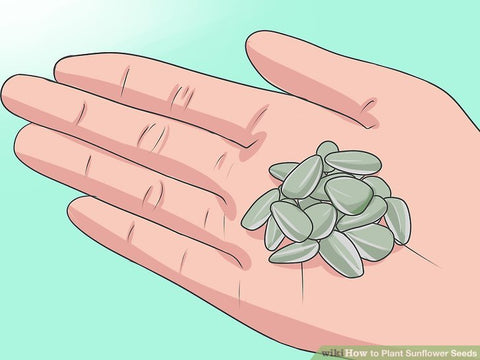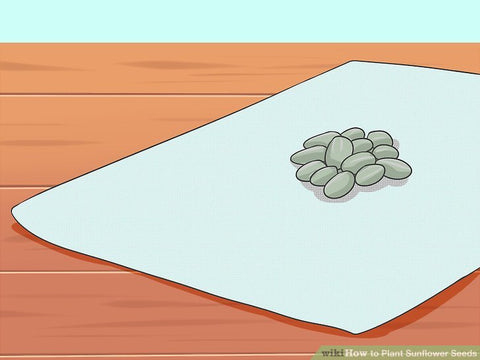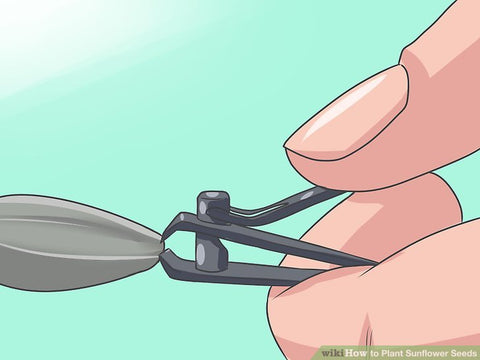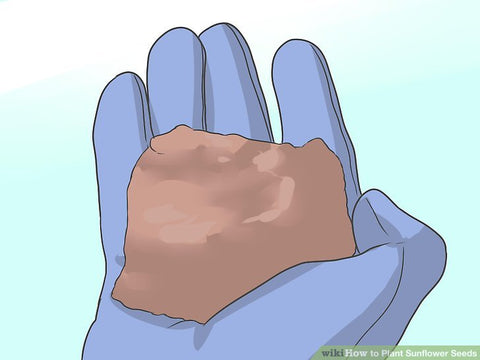Happy Earth Day 2021
How to Plant Sunflower Seeds
Germinating Sunflower Seeds

Check the outdoor temperatures.
-
While sunflowers can be started indoors, they work best if they're started in the ground. Sunflower roots are sensitive to being moved, so transplanting them may kill them. They grow best at temperatures between 64 and 91ºF (18–33ºC), but you can plant at slightly lower temperatures, once the last frost has passed.[1]

Select a sunflower variety.
There are many sunflower varieties and hybrids, but most gardeners will only need to look at a couple characteristics, usually described on the seed packet or online listing. Be sure to check the sunflower's maximum height, since this ranges from dwarf varieties under 1 foot (30 cm), to giant sunflowers 15 ft (4.6 m) or taller. Also, decide between a sunflower that produces one stalk and flower, or one that branches out into multiple stalks with several smaller blooms.
-
It is not possible to grow plants from roasted sunflower seeds, but you can grow it from sunflowers in bird seed, as long as the outer shell is present.[4]

Fold the seeds in a damp paper towel.
Moisten a paper towel slightly, so it is damp but not soaked or dripping. Place the sunflower seeds on one half of the towel, then fold it over to cover them.- If you have a large number of sunflower seeds, and don't mind a lower success rate, you can skip straight to planting. Seeds planted directly in the soil typically take 11 days to emerge.[5]
- If you have a long growing season, try germinating seeds in batches one or two weeks apart, so you'll have blooms in your garden for a longer period of time.

Keep the paper towels in a plastic bag.
Put the damp paper towels in a plastic bag.[6] Check on them once or twice a day, and continue once the seeds have sprouted. Typically, you'll see sprouts emerge from most of the seeds within 48 hours.[7] Once this happens, move on to planting the seeds.- Keep the paper towels at a temperature above 50ºF (10ºC) for best results.[8]

Clip the edge of the seed shells (if necessary)
If the seeds don't sprout within two or three days, try using a fingernail clipper to remove the edge of the shell.[9] Be careful not to damage the seed inside. Add a few more drops of water if the paper towels are drying out.

Choose a sunny location
Sunflowers grow best with six to eight hours of sunlight a day, when they can get it.[10] Choose a location that receives direct sunlight during most of the day.
- Unless your garden receives strong wind, keep the sunflowers away from trees, walls, and other objects that block sunlight.

Check for deep soil drainage.
Sunflowers grow long taproots, and may rot if the soil is waterlogged. Dig a hole 2 feet (0.6 meters) deep to check for hard, compacted soil.[11] If you find any, try mixing compost into your soil bed to improve the drainage.

Consider soil quality.
Sunflowers are not too picky, and can grow in average garden soils without extra treatment. If your soil is poor, or you want to put in the extra effort to encourage growth, mix rich, loamy soil into your planting area. There is rarely any need to adjust your soil pH, but if you already own a pH kit, you may adjust it to between 6.0 and 7.2.[12]
- Rich soil is recommended for giant varieties, since they require more nutrients.[13]

Plant seeds 1 inch (2.5 cm) deep and 6 in. (15 cm) apart.
Plant the seeds in holes or trenches one in. (2.5 cm) deep, or 2 in. (5 cm) if the soil is loose and sandy.[14] Keep seeds at least 6 in. (15 cm) from each other, to give each one enough space to grow. If you only have a few seeds and don't want to thin out the weaker plants later, plant them 1 ft. (30 cm) apart instead, or up to 1.5 ft. (46 cm) for giant varieties. Cover the seeds with soil after planting.
- If you are planting a large sunflower crop, space each trench 30 in (76 cm) apart, or at any distance convenient for your machinery.[15] [16]

Keep soil around young plants moist.
Keep the soil moist, but not soaking wet, until the sprouts emerge from the soil.[17] While the sprouts are still small and fragile, water 3 to 4 inches (7.5 to 10 cm) away from the plant, to encourage root growth without washing the plants away.[18]

Protect the plants from pests.
Birds, squirrels, and snails love sunflower seeds, and may dig them up even before the sprouts have emerged. Cover the ground with netting to make this more difficult without blocking sprouts. Place snail bait or snail repellent in a circle to form a barrier around your planting area.[19]
-
If deer are in your area, encircle the plants with chicken wire once they start growing leaves. You can use a 36 inch (91 cm) piece of chicken wire to surround the leaves and use a few 6 ft. (1.8 m) bamboo poles or wooden stakes to raise the chicken wire as the sunflowers grow. This should protect them from deer.[20]

Water maturing plants weekly
Once the plants have formed stems and an established root system, reduce the watering frequency to once a week. Water generously during the weekly session, and increase the amount of water in dry weather. Sunflowers require more water than most other annual flowers.[21]- The period before and after your plant grows flower buds is a critical time and not getting enough water may damage it.[22] Continue to water the your sunflowers weekly once the flower buds start to form.

Thin the plants (optional)
Once the flowers are about 3 in (7.5 cm) tall, remove the smaller, weaker flowers until the remainder are spaced at least 1 ft (30 cm) apart. This will give the larger, healthier sunflowers more space and nutrients, resulting in taller stalks and larger blooms.- Skip this step if you want small blooms to arrange in bouquets, or if you planted at this spacing to begin with.

Fertilize sparingly or not at all.
- If you are growing sunflowers for your own enjoyment, fertilization is not recommended, since they grow well without it and can suffer if overfed. If you are trying to grow extra-tall sunflowers, or growing them as a crop, dilute the fertilizer in water and pour into a "moat" around the plant, well away from the base.[23] A balanced or nitrogen-rich fertilizer are likely the best options.[24]
-
- Another option is a one time application of slow-release fertilizer, worked into the soil.

Stake plants if necessary
- Plants over 3 ft (0.9 m) may need to be supported with stakes, as do varieties that produce multiple branches.[25] Tie the stalk loosely to the stake using cloth or other soft material.

Harvest the seeds (optional)
Sunflower blooms often last 30–45 days. Toward the end of this period, the green back of the flower head will begin to turn brown.[26] If you want to gather seeds for roasting, or for next year's planting, cover the flowers with paper bags to protect them from birds. Cut off the flowers once fully dry.- If left alone, the flowers will drop seeds for next year's crop. Harvesting them yourself guarantees protection from pests, however.
Source : https://www.wikihow.com/Plant-Sunflower-Seeds


